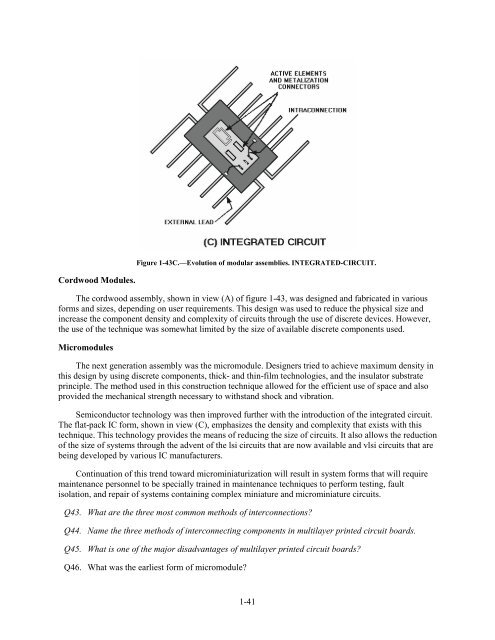Navy Electricity and Electronics Training Series - Historic Naval ...
Navy Electricity and Electronics Training Series - Historic Naval ...
Navy Electricity and Electronics Training Series - Historic Naval ...
You also want an ePaper? Increase the reach of your titles
YUMPU automatically turns print PDFs into web optimized ePapers that Google loves.
Figure 1-43C.—Evolution of modular assemblies. INTEGRATED-CIRCUIT.Cordwood Modules.The cordwood assembly, shown in view (A) of figure 1-43, was designed <strong>and</strong> fabricated in variousforms <strong>and</strong> sizes, depending on user requirements. This design was used to reduce the physical size <strong>and</strong>increase the component density <strong>and</strong> complexity of circuits through the use of discrete devices. However,the use of the technique was somewhat limited by the size of available discrete components used.MicromodulesThe next generation assembly was the micromodule. Designers tried to achieve maximum density inthis design by using discrete components, thick- <strong>and</strong> thin-film technologies, <strong>and</strong> the insulator substrateprinciple. The method used in this construction technique allowed for the efficient use of space <strong>and</strong> alsoprovided the mechanical strength necessary to withst<strong>and</strong> shock <strong>and</strong> vibration.Semiconductor technology was then improved further with the introduction of the integrated circuit.The flat-pack IC form, shown in view (C), emphasizes the density <strong>and</strong> complexity that exists with thistechnique. This technology provides the means of reducing the size of circuits. It also allows the reductionof the size of systems through the advent of the lsi circuits that are now available <strong>and</strong> vlsi circuits that arebeing developed by various IC manufacturers.Continuation of this trend toward microminiaturization will result in system forms that will requiremaintenance personnel to be specially trained in maintenance techniques to perform testing, faultisolation, <strong>and</strong> repair of systems containing complex miniature <strong>and</strong> microminiature circuits.Q43. What are the three most common methods of interconnections?Q44. Name the three methods of interconnecting components in multilayer printed circuit boards.Q45. What is one of the major disadvantages of multilayer printed circuit boards?Q46. What was the earliest form of micromodule?1-41

















